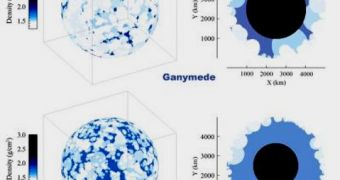For more than 30 years, astronomers have been puzzled by the fact that Jupiter's moons Ganymede and Callisto are very different from each other. The two celestial bodies are made out of a very similar mixture of ice and rock, and are about the same size, but their surfaces and interior states vary widely. This difference was first reported by the Galileo and Voyager spacecraft, and has remained a mystery since. Now, experts at the Southwest Research Institute (SwRI) believe they may have found an explanation for this strange occurrence.
In a paper published in the January 24 online issue of the respected scientific journal Nature Geoscience, the SwRI team reports that cometary impacts may have been the main elements to cause these differences, more specifically the fact that Callisto and Ganymede were not impacted by the same number of comets. The speed at which these collisions occurred was also different for each of the moons, the paper goes on to show. The science group was even able to determine when the differences between the two bodies became most noticeable.
They say that the time of the Late Heavy Bombardment, a period that saw massive impacts between planets, their moons, and asteroids or comets, was when the core and ice structures of the two moons started exhibiting their unique, individual traits. This happened about 3.8 billion years ago, the researchers argue. “Impacts during this period melted Ganymede so thoroughly and deeply that the heat could not be quickly removed. All of Ganymede's rock sank to its center the same way that all the chocolate chips sink to the bottom of a melted carton of ice cream. Callisto received fewer impacts at lower velocities and avoided complete melting,” Dr. Amy C. Barr, an expert at the SwRI Planetary Science Directorate, says.
She worked with colleague Dr. Robin M. Canup to design the computer model that led the group to this conclusion. “Similar to Earth and Venus, Ganymede and Callisto are twins, and understanding how they were born the same and grew up to be so different is of tremendous interest to planetary scientists. Our study shows that Ganymede and Callisto record the fingerprints of the early evolution of the solar system, which is very exciting and not at all expected,” Barr further reveals.

 14 DAY TRIAL //
14 DAY TRIAL // 
